小学六年级英语四种时态总结
六年级必学英语时态
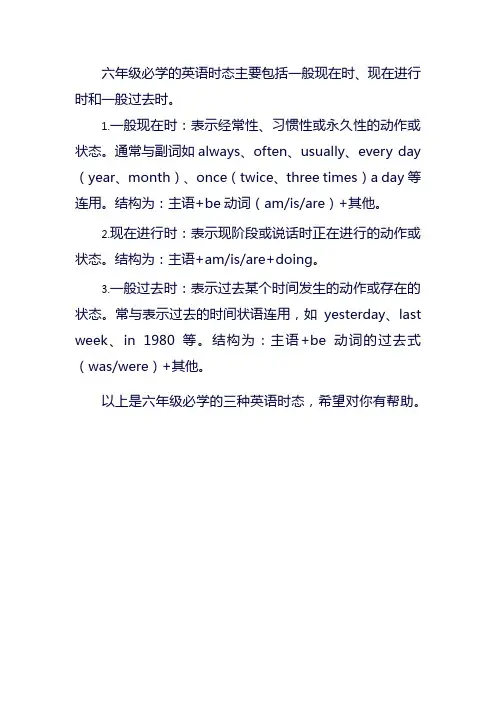
六年级必学的英语时态主要包括一般现在时、现在进行时和一般过去时。
1.一般现在时:表示经常性、习惯性或永久性的动作或状态。
通常与副词如always、often、usually、every day (year、month)、once(twice、three times)a day等连用。
结构为:主语+be动词(am/is/are)+其他。
2.现在进行时:表示现阶段或说话时正在进行的动作或状态。
结构为:主语+am/is/are+doing。
3.一般过去时:表示过去某个时间发生的动作或存在的状态。
常与表示过去的时间状语连用,如yesterday、last week、in 1980等。
结构为:主语+be动词的过去式(was/were)+其他。
以上是六年级必学的三种英语时态,希望对你有帮助。
小学六年级英语 时态总结

时态总结一、一般现在时标志词:always(总是) usually(通常) often(经常) sometimes(有时) never(从不) every(每一)行为动词的词型变化形式一般现在时动词只有第三人称有词形变化,其他人称(第一人称:I, we;第二人称:you;第三人称复数:they、my friends)动词均用原形当主语是第三人称单数时,一般动词在一般现在时句子中的变化规律:1、多数在动词后加s play—plays like—likes ,2、以s,x,sh,ch,o结尾的动词加es wash–washes catch–catches do–does3、以辅音字母加y结尾,把y改i再加es fly—flies study—studies4、以元音字母加y结尾,直接加s buy –buys5、不规则变化have—has一般现在时基本用法功能1.表示事物或人物的特征、状态。
如:The sky is blue.天空是蓝色的。
2.表示经常性或习惯性的动作。
如:I get up at six every day.我每天六点起床。
3.表示客观现实。
如:The earth goes around the sun.地球绕着太阳转。
构成1. be动词:主语+be(am,is,are)+其它。
如:I am a boy.我是一个男孩。
2.行为动词:主语+行为动词(+其它)。
如:We study English.我们学习英语。
句型肯定句:①be动词:主语+ be + 其它成分He is a worker.②行为动词:主语+动词(注意人称变化) +其它成分We like the little cat.否定句:①be动词:主语+ be + not +其它成分They are not students.②行为动词:主语+助动词(do/does) + not +动词原形+其它成分We don’t like the cat.一般疑问句:①be动词:Am / Is /Are +主语+ 其它成分Are you a teacher? Yes, I am. / No, I am not.Are they students of your school? Yes they are / No they aren’t.②行为动词:助动词(Do/Does)+主语+动词原形+ 其它成分Do you like it? Yes, I do. / No. I don’t.Does he (she) like it? Yes, he (she) does. / No, he (she) doesn’t.特殊疑问句:疑问词+ 一般疑问句①be动词:How many students are there in your school?②行为动词:What do you usually do on Sunday?一般现在时动词be和have的变化形式1.动词Be叫连系动词, 用法:第一人称单数用am,第三人称单数用is,其它人称用are。
英语人教版六年级知识点
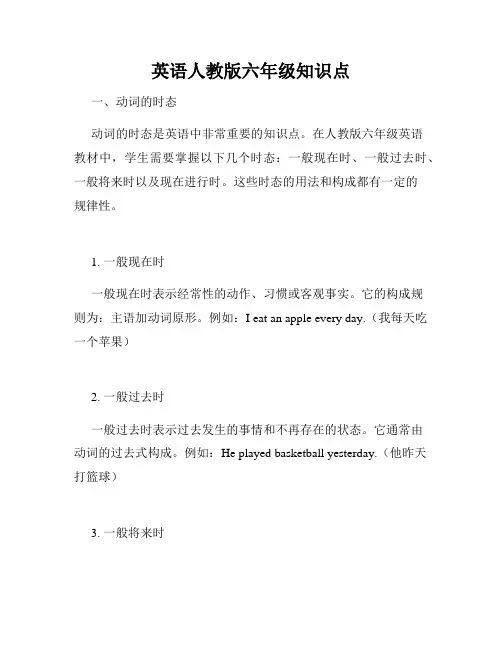
英语人教版六年级知识点一、动词的时态动词的时态是英语中非常重要的知识点。
在人教版六年级英语教材中,学生需要掌握以下几个时态:一般现在时、一般过去时、一般将来时以及现在进行时。
这些时态的用法和构成都有一定的规律性。
1. 一般现在时一般现在时表示经常性的动作、习惯或客观事实。
它的构成规则为:主语加动词原形。
例如:I eat an apple every day.(我每天吃一个苹果)2. 一般过去时一般过去时表示过去发生的事情和不再存在的状态。
它通常由动词的过去式构成。
例如:He played basketball yesterday.(他昨天打篮球)3. 一般将来时一般将来时表示将来要发生的动作或存在的状态。
它的构成规则为:主语加将/将来要+动词原形。
例如:I will go to the park tomorrow.(明天我将去公园)4. 现在进行时现在进行时表示现在正在进行的动作。
它的构成规则为:主语加be动词的现在分词。
例如:They are playing football now.(他们现在正在踢足球)二、名词的单复数名词的单数和复数形式也是六年级英语教材中需要掌握的重要知识点。
常见的名词复数形式有以下几种:1. 以-s结尾的名词,直接在词尾加-s。
例如:cats(猫)、books(书)2. 以-s、-ch、-sh、-x和-o结尾的名词,在词尾加-es。
例如:buses(公共汽车)、boxes(盒子)3. 以辅音字母+y结尾的名词,先将y变为i,再加-es。
例如:butterflies(蝴蝶)4. 以-f或-fe结尾的名词,一般将f或fe变为v,再加-es。
例如:leaves(叶子)、lives(生活)5. 不规则复数形式。
有许多名词的复数形式是不按规则变化的,需要直接记忆。
例如:children(孩子们)、tooth(牙齿)三、形容词的比较级和最高级学习形容词的比较级和最高级也是人教版六年级英语教材中的重点内容。
英语六年级时态综合讲解
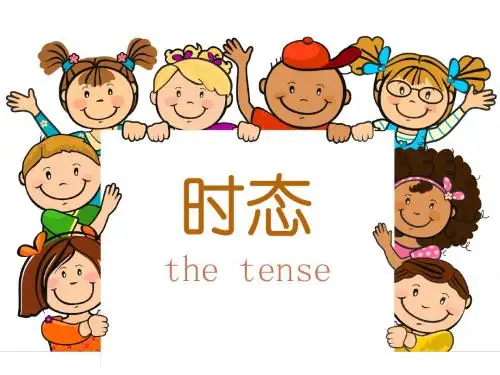
_April 1st (date)
Last Friday,we had an open day in our school. Students of Grade One put on socks. Students of Grade two will fold their clothes. folded Students of Grade Three will wash their socks and washed towels. Students of Grade One cleaned up the beds. Students of Grade One made make fruit salad. Students of Grade One cooked will cook noodles. How happy they were are ! Xiao Rui
1. + ing
I
am
+ doing
动词ing
e.g. doing
2. 末尾只有一个辅 音字母的重读闭音 节要双写最后一个 字母+ing e.g. swimming running getting 3. 以哑巴e结尾, 要去e再+ing e.g. write ----writing take ----taking
Take some photos when you are making.Take some notes about how you made it.Then write a diary about the cooking after class.
plays 1. Peter ________ (play) basketball every week.
六年级英语总复习(时态-语法)
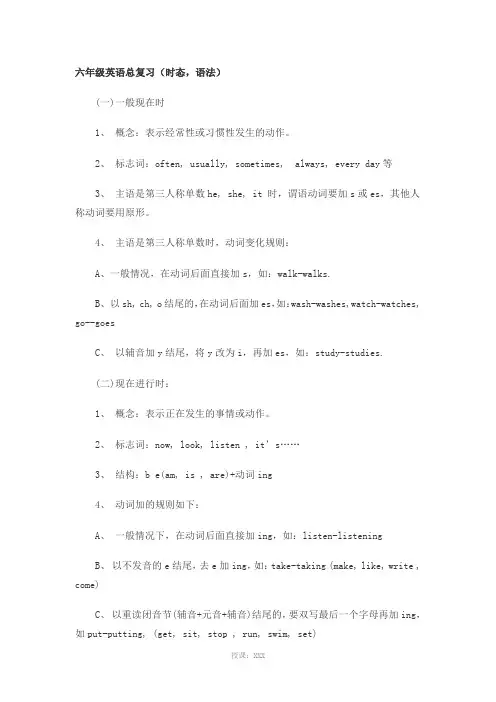
六年级英语总复习(时态,语法)(一)一般现在时1、概念:表示经常性或习惯性发生的动作。
2、标志词:often, usually, sometimes, always, every day等3、主语是第三人称单数he, she, it 时,谓语动词要加s或es,其他人称动词要用原形。
4、主语是第三人称单数时,动词变化规则:A、一般情况,在动词后面直接加s,如:walk-walks.B、以sh, ch, o结尾的,在动词后面加es,如:wash-washes,watch-watches, go--goesC、以辅音加y结尾,将y改为i,再加es,如:study-studies.(二)现在进行时:1、概念:表示正在发生的事情或动作。
2、标志词:now, look, listen , it’s……3、结构:b e(am, is , are)+动词ing4、动词加的规则如下:A、一般情况下,在动词后面直接加ing,如:listen-listeningB、以不发音的e结尾,去e加ing,如:take-taking (make, like, write , come)C、以重读闭音节(辅音+元音+辅音)结尾的,要双写最后一个字母再加ing,如put-putting, (get, sit, stop , run, swim, set)但:see-seeing, eat –eating.(三)一般将来时:1、概念:表示将要发生的事或打算,计划要做的事。
2、标志词:this weekend, next Monday, tomorrow, in seven years’ time3、结构:be(am, is , are) going to +动词原形或者 Will+动词原形如:I am going to take a trip next week.4、否定句:be+not going to +动词原形或者 Will+not(等于won’t)+动词原形(四)一般过去时:1、概念:表示在过去的时间里所发生的事或动作。
六年级下册英语素材 四种动词时态归纳及试题 全国通用
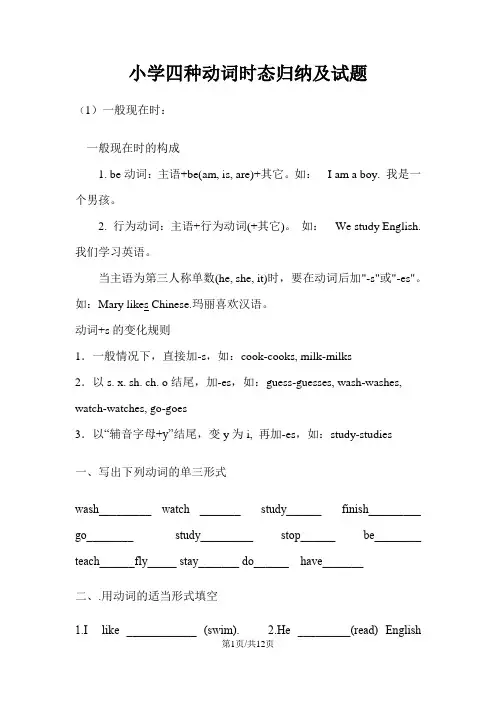
小学四种动词时态归纳及试题(1)一般现在时:一般现在时的构成1. be动词:主语+be(am, is, are)+其它。
如:I am a boy. 我是一个男孩。
2. 行为动词:主语+行为动词(+其它)。
如:We study English. 我们学习英语。
当主语为第三人称单数(he, she, it)时,要在动词后加"-s"或"-es"。
如:Mary likes Chinese.玛丽喜欢汉语。
动词+s的变化规则1.一般情况下,直接加-s,如:cook-cooks, milk-milks2.以s. x. sh. ch. o结尾,加-es,如:guess-guesses, wash-washes, watch-watches, go-goes3.以“辅音字母+y”结尾,变y为i, 再加-es,如:study-studies一、写出下列动词的单三形式wash_________ watch _______ study______ finish_________ go________ study_________ stop______ be________ teach______fly_____ stay_______ do______ have_______二、.用动词的适当形式填空1.I like ____________ (swim).2.He _________(read) Englishevery day.3.We ______(go)to school at seven in the morning.4.Mike_______(go)to school at seven in the morning.5.My mother_______(like) ______(go) shopping.6.I can ________(draw) many beautiful pictures.7. he________(like)_________(jump) ?8.The teachers (not like)__________(dance).9.The teacher (not like)_________(dance).10.The students___________(speak) English in class.11.The student_________(speak) Chinese after class.12. _______your sister (study) English at school ? No , she__________ . (not )三、用所给的人称改写句子1.I take photos on Sunday. ( Mike)2.We plant beautiful flowers. (she)3.They like playing basketball. (Ben)4.I listen to music every day. (my aunt)四、改句子1.Do you often play football after school? (肯定回答)2.Gao Shan's sister likes playing table tennis (改为否定句)3.She lives in a small town near New York. (改为一般疑问句)4.I watch TV every day. (改为一般疑问句)5.Nancy doesn't run fast.(肯定句)6.I usually play football on Friday afternoon. (否定句: 一般疑问句: 划线提问)●Su Yang usually washes some clothes on Saturday.(同11)●Tom does his homework at home.(同11)(2)一般过去时:动词过去式详解动词的过去式的构成规则有:A、规则动词①一般直接在动词的后面加ed:如worked , learned , cleaned ,visited①以e结尾的动词直接加d:如lived , danced , used①以辅音字母加y结尾的动词要改y为i再加ed(此类动词较少)如study – studied carry – carried worry – worried (注意play、stay不是辅音字母加y,所以不属于此类)① 双写最后一个字母(此类动词较少)如stoppedB、不规则动词(此类词并无规则,须熟记)小学阶段要记住以下动词的原形和过去式:sing – sang , eat – ate ,see – saw , have – had , do – did , go – went , take – took , buy – bought , get – got , read – read ,fly – flew , am/is – was ,are – were , say – said , leave – left , swim – swam , tell – told , draw – drew , come – came , lose – lost , find – found , drink – drank , hurt – hurt , feel – felt一、写出下列动词的过去式is\am_________have_______ plant________ are ________drink_________ play_______ go________ read ________does_________ dance________ worry________ sleep_____buy_________ eat__________ see________ take ______二、用动词的适当形式填空1. It ______ (be) B en’s birthd ay last Friday.2. We all ______ (have) a good time last night.3. I ______(be) an English teacher now.4. She _______(be) happy yesterday.5. _______ they ________ (clean) the room last Sunday? No, they _____.6. We ___________ (go) to school three days ago.7. What ____ you ______ just now? I _______ some housework. (do)8. He _________ (live) in Wu xi two years ago.9. The cat ________ (eat) a bird last night.10. We _______ (have) a party last Halloween.11. They ________ (play) chess in the classroom last PE lesson.三、句型转换1. They played football in the playground.否定句:________________________________________________一般疑问句:____________________________________________ 肯、否定回答:__________________________________________2. Nancy went to school early.否定句:________________________________________________一般疑问句:____________________________________________ 肯、否定回答:__________________________________________3. There was a car in front of the house just now.否定句:________________________________________________一般疑问句:____________________________________________ 肯、否定回答:__________________________________________ 肯、否定回答:__________________________________________(3)一般将来时:基本结构:①be going to + do;①will+ do. be going to = willI am going to go swimming tomorrow(明天). = I will go swimming tomorrow.一、改句子。
小学六年级英语-时态总结
小学六年级英语-时态总结-CAL-FENGHAI.-(YICAI)-Company One1时态总结一、一般现在时标志词:always(总是) usually(通常) often(经常) sometimes(有时) never(从不) every(每一)行为动词的词型变化形式一般现在时动词只有第三人称有词形变化,其他人称(第一人称:I, we;第二人称:you;第三人称复数:they、my friends)动词均用原形当主语是第三人称单数时,一般动词在一般现在时句子中的变化规律: 1、多数在动词后加s play—plays like—likes ,2、以s,x,sh,ch,o结尾的动词加es wash–washes catch–catches do–does3、以辅音字母加y结尾,把y改i再加es fly—flies study—studies4、以元音字母加y结尾,直接加s buy – buys5、不规则变化 have—has一般现在时基本用法功能1.表示事物或人物的特征、状态。
如:The sky is blue.天空是蓝色的。
2.表示经常性或习惯性的动作。
如:I get up at six every day.我每天六点起床。
3.表示客观现实。
如:The earth goes around the sun.地球绕着太阳转。
构成1. be动词:主语+be(am,is,are)+其它。
如:I am a boy.我是一个男孩。
2.行为动词:主语+行为动词(+其它)。
如:We study English.我们学习英语。
句型肯定句:① be动词:主语+ be + 其它成分 He is a worker.②行为动词:主语+动词(注意人称变化) +其它成分 We like the little cat.否定句:①be动词:主语+ be + not +其它成分 They are not students.②行为动词:主语+助动词(do/does) + not +动词原形+其它成分We don’t like the cat.一般疑问句:①be动词: Am / Is /Are +主语 + 其它成分Are you a teacher Yes, I am. / No, I am not.Are they students of your schoolYes they are / No they aren’t.②行为动词:助动词(Do/Does)+主语+动词原形 + 其它成分Do you like it Yes, I do. / No. I don’t.Does he (she) like itYes, he (she) does. / No, he (she) doesn’t.特殊疑问句:疑问词+ 一般疑问句①be动词: How many students are there in your school②行为动词:What do you usually do on Sunday?一般现在时动词be和 have的变化形式1.动词Be叫连系动词, 用法:第一人称单数用am,第三人称单数用is,其它人称用are。
外研版六年级上册英语第1、2天复习的四大时态
小学四大时态(一般现在时、现在进行时、一般将来时、一般过去时)一般现在时一般现在时:表示通常性、规律性、习惯性的状态或者动作(有时间规律发生的事件)的一种时间状态。
1.“经常发生的动作”,比如每天起床、吃饭、上学,一个星期去几次超市或新华书店等。
这些事件中,有的是有规律的,有的是偶尔做几次。
这些都算经常发生的事件。
我们要告诉人们的,是这个动作经常发生,是一般的情况而不是具体的某一次。
2.事物存在的状态。
3.有些动作或状态是永恒的,比如长江向东流、地球绕着太阳转,肯定式疑问式否定式否定疑问式I work. Do you work? I don't work. Don't you work? You work. Do you work? You don't work. Don't you work? We work. Do you work? We don't work. Don't you work? They work. Do they work? They don't work. Don't they work?He(She,It) w orks. Does he(she,it)work?He(She,It) doesn't work.Doesn't he(she it) work?基本用法1表示经常性或习惯性的动作或存在的状态2表示客观事实或普遍真理3在时间、条件等状语从句中,用现在时表示将来4在某些以here,there开头的句子中,用一般现在时表示正在发生的动作当主语是第三人称单数时:动词变相应的第三人称单数形式肯定句主语+动词s+其它否定句主语+doesn't+动词原形+其它一般疑问句Does+主语+动词原形+其它肯定回答Yes,主语+does否定回答No,主语+doesn't特殊疑问句特殊疑问词+一般疑问句一般现在时的分析当主语不是第三人称单数时:肯定句主语+动词原形+其它否定句主语+don't+动词原形+其它一般疑问句Do+主语+动词原形+其它要注意,句式结构错则全都错。
(完整版)小学六年级英语四种时态复习
(完整版)⼩学六年级英语四种时态复习四种时态复习⼀般现在时的基本概念⼀般现在时表⽰现在经常反复发⽣的动作、存在的状态或习惯性的动作的时态。
常见的标志词(时间状语)主要有:every…,sometimes, at-, on Sundays, uauslly often, never, always 等。
⼀般现在时的结构be动词的⼀般现在时主语+ Be动词+其他成分I am a boy.实义动词的⼀般现在时主语+⾏为动词 +其他成分We study English.⼀般现在时的具体形式be动词的⼀般现在时1. 第⼀⼈称单数I+amI am a student.2. 第⼆⼈称单数you和其他⼈称复数we/you/they+areYou are a lucky girl.We arestudents in this school.3. 第三⼈称单数he/she/it+isShe is my teacher.例题:⽤be动词的适当形式填空。
1. I from China.2. It very hot today.3. They in the hospital.4. We good students.5. She a beautiful girl.实义动词的⼀般现在时1. 第⼀、⼆⼈称单数I/you和其他⼈称复数we/you/they+动词原形I get up at 8 o'clock.They go to school everyday.2. 第三⼈称单数he/she/it+实义动词第三⼈称单数形式It runs fast.He studies hard.例题:⽤说给单词的适当形式填空。
1. We ____ h ome every day. (go)2. Trees __ —green in spring. (turn)3. He ____ very hard. (study)4. The boy - ___ up at seven O'clock. (get)5. The earth ____ round the sun. (move)补充:主语为第三⼈称单数形式,谓语动词的变化规则:般现在时的句型变化 be 动词的⼀般现在时否定句主语 + be 动词 + not +其他He is not a worker.特殊疑问句特殊疑问词 + ⼀般疑问句Where is he?例题:写出下列句⼦中所缺的be 动词,并⽤肯定及否定形式回答。
六年级英语时态总结
六年级英语时态总结六年级英语时态总结一、一般现在时1.定义:表示经常或习惯发生的动作或存在的状态,通常与时间状语usually、often、always、sometimes、every day、once a week连用。
例如:She often reads newspa-pe-rs aftert supper。
她经常在晚饭后看报。
2.一般现在时还可以表示客观事实或普遍真理。
例如: The earth moves round the sun。
地球围绕太阳转。
3.主语为第三人称(他、她、它、人名)单数时,其后动词也要变成相应形式即复数形式。
例如:Mike every day goes to school.4.含be动词/含实义动词的基本句型:a肯定句:主语+be动词的一般现在时(am/is/are)+… 例如:He is a boy./主语+动词的一般现在时+…,例如:He usually goes to school。
b一般疑问句:Be+主语+…例Is he a boy?肯答Yes, he is;否定答:No,he isn’tDo/Does+主语+动词原形+…例Does he go to school usually?Yes he does/No he does’ntc特殊疑问句:特殊疑问词+be+主语+动词原形。
例what is his name?特殊疑问词+do/does+主语+动词原形。
why does he go to school usually?二、现在进行时1. 定义:表示现在正在进行的动作或行为。
2. 现阶段两种用法:第一、表示此时此刻正在进行的动作。
例如Is it snowing now?现在在下雪吗?第二、表示现阶段正在进行的动作,但说话时动作不一定正在进行。
例如:He is translating a book. 他正在翻译一本书。
3.基本句型:a肯定句:主语+be(am/is/are)+动词现在分词+…例She is reading a book。
- 1、下载文档前请自行甄别文档内容的完整性,平台不提供额外的编辑、内容补充、找答案等附加服务。
- 2、"仅部分预览"的文档,不可在线预览部分如存在完整性等问题,可反馈申请退款(可完整预览的文档不适用该条件!)。
- 3、如文档侵犯您的权益,请联系客服反馈,我们会尽快为您处理(人工客服工作时间:9:00-18:30)。
小学六年级英语四种时态总结一、一般现在时标志词:always(总是) usually(通常) often(经常) sometimes(有时) never(从不) every(每一)行为动词词型变化形式一般现在时动词只有第三人称有词形变化,其他人称(第一人称:I, we;第二人称:you;第三人称复数:they、my friends)动词均用原形当主语是第三人称单数时,一般动词在一般现在时句子中的变化规律:1、多数在动词后加s play—plays like—likes ,2、以s,x,sh,ch,o结尾的动词加es wash–washes catch–catches do–does3、以辅音字母加y结尾,把y改i再加es fly—flies study—studies4、以元音字母加y结尾,直接加s buy –buys5、不规则变化have—has一般现在时基本用法功能1.表示事物或人物的特征、状态。
如:The sky is blue.天空是蓝色的。
2.表示经常性或习惯性的动作。
如:I get up at six every day.我每天六点起床。
3.表示客观现实。
如:The earth goes around the sun.地球绕着太阳转。
The earth is round.构成1. be动词:主语+be(am,is,are)+其它。
如:I am a boy.我是一个男孩。
2.行为动词:主语+行为动词(+其它)。
如:We study English.我们学习英语。
句型肯定句:A.be动词:主语+ be + 其它成分He is a worker.B.行为动词:主语+动词(注意人称变化) +其它成分We like the little cat.否定句:A.be动词:主语+ be + not +其它成分They are not students.B.行为动词:主语+助动词(do/does) + not +动词原形+其它成分We don't like the little cat.一般疑问句:A.be动词:Am / Is /Are +主语+ 其它成分Are you a teacher? Yes, I am. / No, I am not.Are they students of your school.Yes they are / No they aren,t.B.行为动词:助动词(Do/Does)+主语+动词原形+ 其它成分Do you like it? Yes, I do. / No. I don't .Does he(she) like it? Yes, he( she )does. / No, he ( she )doesn't.特殊疑问句:疑问词+ 一般疑问句A.be动词:How many students are there in your school?B.行为动词:What do you usually do on Sunday?一般现在时动词be和have的变化形式。
are,其它人称用is,第三人称单数用am用法:第一人称单数用, 叫连系动词Be 动词1. :。
如has以外,其它人称一律用have2.动词have的用法:第三人称单数用,特别在疑问句和否定句中。
代替have 1.在英国,人们常用have got注意事项do, does 时,构成疑问或否定句时,就借助于助动词有”2.当have如果不表示“)表示有否:I have not a new pen. ( 如:I have a new pen .)表示吃'clock. (否:I don't have lunch at 12 o I have lunch at 12 o'clock.二.现在进行时:.时间It's+标志词:now, look, listen,表示正在进行的、发生的动作: 现在进行时基本结构:ambe is + 动词ingare肯定句:主语+ be动词(am, are, is)+ 现在分词(ing)+ 其他I am watching TV.否定句:主语+ be动词+ not + 现在分词(ing)+ 其他I am not watching TV.一般疑问句:Be动词(Am, Are, Is) + 主语+ 现在分词(ing)+ 其他Are you watching TV? Yes, I am. / No, I am not.特殊疑问句:疑问词+ 一般疑问句What are you doing?动词的-ing形式的变化规律:1. 直接加-ing watch—watching clean—cleaning2. 以-y结尾的动词,直接加-ing study—studying play—playing3. 以不发音的-e结尾的动词,先去-e再加-ing make—making come—coming4. 末尾只有一个元音字母和一个辅音字母的重读闭音节动词,双写末尾字母,再加-ing cut—cutting三、一般将来时的用法:表示将来某一时刻的动作或状态,或将来某一段时间内经常的动作或状态。
标志词:tomorrow(明天),the day after tomorrow(后天),next (下一个),from now on(从现在开始),in the future(将来),soon(不久)等结构:( 1 ) be(am,is ,are)+going to+动词原形( 2 ) will+动词原形“be going to+动词原形(打算…)”= ”will+动词原形(将,会…)”I will study tomorrow.I'm going to study tomorrow.(be going to着重于事先考虑好will 未事先考虑好)----一般不用考虑肯定句:主语+ be (am, are, is) going to + 动词原形.主语+ will + 动词原形否定句:主语+ be (am, are, is) not going to + 动词原形.主语+ won't + 动词原形.一般疑问句:Be (Am, Are, Is) + 主语+ going to + 动词原形?Will + 主语+ 动词原形?特殊疑问句:疑问词+ 一般疑问句?注意:will 常简略为'll,并与主语连写在一起,如:I'll,he'll,it'll,we'll,you'll,they'll。
四、一般过去时标志词:yesterday(昨天), last (上一个), this morning(今天早上),ago(以前),before (在…之前), in 2002(在2002年) 等用法:表示过去某个时间发生的动作或存在的状态,常和表示过去的时间状语连用。
也表示过去经常或反复发生的动作动词过去式变化规则:1.一般在动词末尾加-ed 如:watch-watched, cook-cooked2.结尾是e加d 如:taste-tasted3.末尾只有一个元音字母和一个辅音字母的重读闭音节,应双写末尾的辅音字母,再加-ed,如:stop-stopped4.以“辅音字母+y”结尾的,变y为i,再加-ed,如:study-studied5.不规则动词过去式:am,is-was, are-were, do-did, see-saw, say-said, give-gave…句型:1、Be动词在一般过去时中的变化:⑴am 和is 变为was。
否定(was not=wasn't)⑵are变为were。
否定(were not=weren't)否定句:在was或were后加not一般疑问句:把was或were调到句首。
2、行为动词在一般过去时中的变化否定句:didn't + 动词原形如:Jim didn't go home yesterday.一般疑问句:在句首加Did,句子中的动词过去式变回原形如:Did Jim go home yesterday? 特殊疑问句:(1)疑问词+did+主语+动词原形?如: What did Jim do yesterday?(2)疑问词当主语时:疑问词+动词过去式?如:Who went to home yesterday?附录:小学常用不规则动词过去式一、不规则动词的过去式的构成1.把动词原形中的i改为a,变成过去式。
如:begin—began,drink—drank,give—gave,ring—rang,sing—sang,sit—sat,swim—swam2.把重读开音节中的i改为o,变成过去式。
如:drive—drove,ride—rode,write—wrote3.改动词原形中的aw /ow为ew,变成过去式。
如:draw—drew,grow—grew,know—knew,throw—threw(动词show除外,show —showed)4.动词原形中的e改为o,变成过去式。
如:get—got,forget—forgot5.动词原形中的ee改为e,变成过去式。
如:feed—fed,meet—met6.动词原形中的eep改为ept,变成过去式。
如:keep—kept,sleep—slept,sweep—swept7.动词原形中的eak改为oke,变成过去式。
如:break—broke,speak—spoke8.动词原形中的ell改为old,变成过去式。
如:sell—sold,tell—told9.动词原形中的an改为oo,变成过去式。
如:stand—stood,understand—understood10.以ought和aught结尾,且读音是〔 :t〕的过去式。
如:bring—brought,buy— bought,think—thought,catch—caught,teach—taught11.以ould结尾且读音为〔ud〕的情态动词过去式。
如:can—could,shall—should,will—would12.把动词原形中的o改为a,变成过去式。
如:come—came,become—became13.在动词原形后加d或t变成过去式,并且发生音变。
如:hear〔hi 〕—heard〔h :d〕, say〔sei〕—said〔sed〕,mean〔mi:n〕—meant 〔ment〕14.动词的过去式与动词原形一样。
如:let—let,must—must,put—put,read—read〔red〕二.不规则动词表原形过去式中文释义am was 是(表示存在、状态等)是(表示存在、状态等)are werebecome became 成为;变成begin began 开始break broke 打破bring brought 拿来;取来;带来build built 构筑;建造;建筑buy bought 购买;买can could 可以;能;可能;会catch caught 赶上(车船等);捕获come came 来;来到cut cut 切;割;削;剪做;干;行动 do/does did画draw drew喝;饮drink drank开车;驾驶 drive drove吃eat ate感到;觉得feel felt寻找;查找 find found飞行 fly flew忘记;忘却forget forgot变得get got给;授予 give gave去go went得(病);患(病);有;吃;饮 have/has hadhear heard 听见;听说 hide hid隐藏 is was 是(表示存在、状态等) keepkept 保持;使保持某种状态 know knew 知道;了解离去;出发leave left允许;让let let失去;丧失lose lost使;促使;迫使;做;制作make made可能;可以may might表示……的意思;作……的解释mean meantmeet met 遇见;相逢 put put放;摆;装 read read /e/ 读;阅读 ride rode 骑(铃)响 ring rangrise rose 上升跑;奔跑run ransay said 说;讲看见see saw发送;寄;派;遣send sentset set 放, 置show showed 出示;给……看shut shut 关上(门、盖、窗户等)sing sang 唱;唱歌sit sat 坐sleep slept 睡;睡觉speak spoke 说;说话swim swam 游泳take took 搭乘;花费(时间);拿走;带到teach taught 教;讲授tell told 告诉;讲述think thought 想;思考will would 将要win won 赢;获胜write wrote 书写小学英语语法(词性)总结一、形容词、副词的比较级和最高级的用法:当两种物体之间相互比较时,我们要用形容词或副词的比较级;当相互比较的物体是三个或三个以上时,用形容词或副词的最高级。
